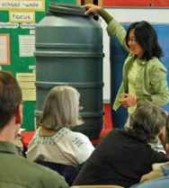
Tara gives lessons on free water Bill Gates Foundation has just budgeted $4m to investigate the potential of rainwater harvesting in the third world. But what about the first world?
America is rapidly catching on to water caching, as rainwater harvesting is also known.
In the Bay Area, Tara Hui, a rainwater campaigner, climbed under her deck, nudged past a cluster of 55-gallon barrels and a roosting chicken, and pointed to a shiny metal gutter spout.
“See that?” she said. “That’s where the rainwater comes in from the roof.”
Hui is one of a growing band of people across the country turning to collected rainwater for non-drinking uses like watering plants, flushing toilets and washing laundry, reports Associated Press.
Concern over drought and wasted resources, and stricter water conservation laws have revitalized the practice of capturing rainwater during storms and stockpiling it for use in drier times. A fixture of building design in the Roman empire and in outposts along the American frontier, rainwater harvesting is making a comeback in states including Texas, North Carolina, and California.
“We call it ‘the movement that’s taking the nation by storm,'” said Robyn Hadley, spokeswoman for the Austin, Texas-based American Rainwater Catchment Systems Association, whose membership has jumped by more than 40 percent this year.
Hui, 37, got her first 55-gallon plastic barrel for free five years ago. The barrel had been packed with maraschino cherries, so when rain first filled it the water smelled like candied fruit.
Now, she has a daisy chain of 25 linked barrels under her back deck with a combined capacity of nearly 1,250 gallons. She built the system herself, after searching the Internet for information and buying the necessary plumbing parts at a hardware store. The whole setup cost her $200.
The average American uses 101 gallons of water a day at home and in the yard. Add in agricultural and industrial water use and that climbs to an average of 1,430 gallons per day per person.
Scientists warn that climate change will result in more severe droughts and erratic storms worldwide, and this spring was the driest in California’s 114 years of record-keeping. Extreme drought and abnormally dry conditions persist across large swaths of the country, with states in the West and Southeast hardest hit.
Even in a drought, it only takes a few hours of heavy rain to fill all 25 of Hui’s barrels. She uses that water throughout the summer to irrigate her backyard.
This fall, San Francisco will try to recruit more people to hoard the rain. The city will be putting $100,000 toward hosting how-to workshops and offering rebates and discounts on rainwater catchment tanks.
In addition to conserving water, these efforts help alleviate the problem of storm runoff. Asphalt-covered roads, sidewalks and parking lots repel storm water, forcing it down storm drains and into creeks rather than allowing it to soak into soil. Big flushes of storm water in water treatment systems can send raw sewage flowing into the ocean. Overloaded streams can cause flooding and damage salmon habitat.
Elsewhere, roofs are being used to collect rain from Austin to Seattle. Santa Monica’s new library sits atop a 200,000-gallon rainwater cistern, and in August the city launched a rainwater rebate program for homeowners. In Marin County, a recent seminar on rainwater harvesting attracted a standing-room-only crowd of several hundred.
Doug Pushard, a software entrepreneur and rain collection enthusiast based in Santa Fe, N.M., runs HarvestH2O.com, a Web-based organization providing information on rainwater harvesting. It got more than 23,000 page views in July, almost triple the number he got in the same month last year, along with numerous calls and e-mails.
New companies and ingenuity in plumbing and policy are pushing rainwater harvesting from the off-the-grid fringe to the core of 21st century green building design.
“You still have to be a tinkerer to make things work, but that’s changing,” said Pushard.
Every year, Sunset Magazine sponsors several “idea houses” featuring sustainable building design. As many as 40,000 people stream through each house to study the latest in green architecture. The 2007 idea houses in San Francisco and Lake Tahoe collected rainwater, as will this year’s idea house in Monterey.
“We’re going to see a lot more design features for recycled water and rainwater catchment,” said Dave Walls, executive director of the California Building Standards Commission, which in July adopted new building codes for the state requiring new buildings to strictly conserve water.
In June, The Bill & Melinda Gates Foundation gave a Washington-based nonprofit $4.2 million to determine whether rainwater harvesting could provide potable water to the billions of poor people worldwide who lack access to clean water. Drought-prone and groundwater-scarce places like Australia, the Bahamas, Iran and parts of India are already busy pooling precipitation.
“People don’t think about where their water comes from or how much they use,” Hui said as she used her collected rainwater for irrigation. “We all need to.”